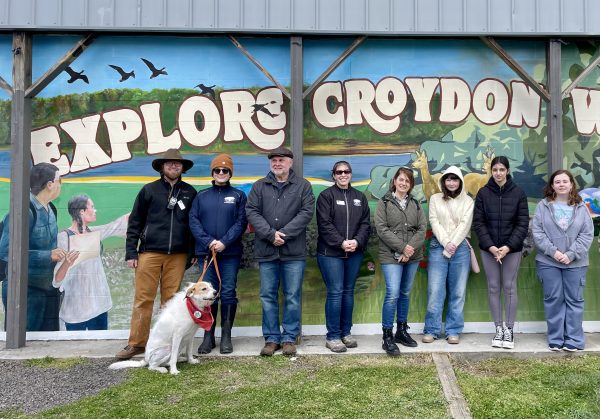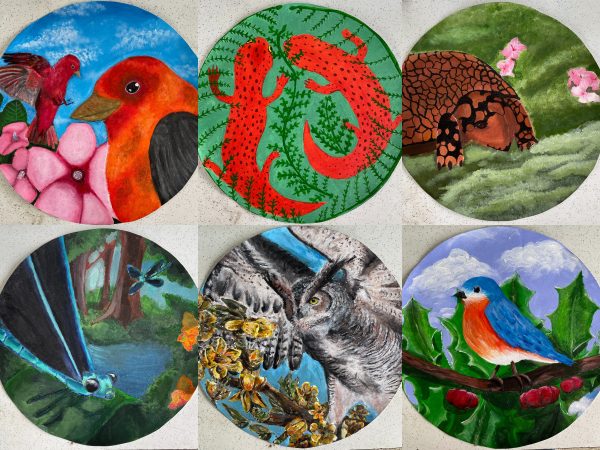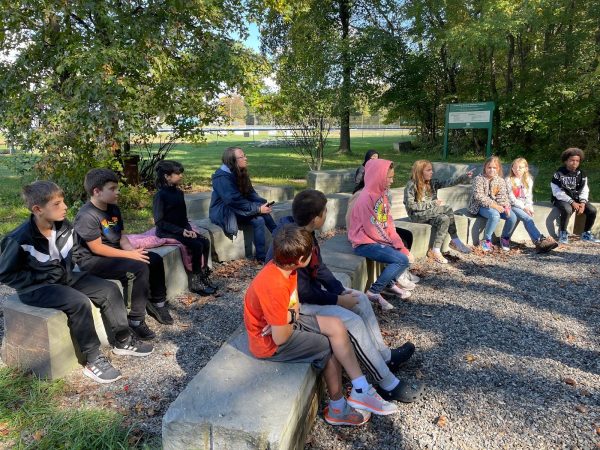On the first Saturday in April, Heritage Conservancy unveiled a colorful new mural highlighting the biodiversity and hiking appeal of Croydon Woods Nature Preserve. The work includes student artists from nearby Harry S. Truman High School and features plant and animal species from Croydon Woods – a habitat that has been actively improved under the ownership and stewardship of Heritage Conservancy, with help from the community.
“We have worked with the community to remove over 20,000 pounds of trash,” said Heritage Conservancy’s CEO Bill Kunze at the unveiling. “This was a place that was not loved. This is a place that was abused. In partnership with the community, we have worked hard to turn this into a place that can love nature again, and also a place that people can love.”
The mural is located on the side of the concession stand at the Lower Bucks County Athletic Association baseball fields, near Keystone Elementary School, where we partner to offer environmental education programs in Croydon Woods Nature Preserve. Along with an outdoor classroom, new kiosks, and other signage, it is part of placemaking for this unique forest.
“We want to make this a place where people feel welcome, where they can spend time watching a little league game or walking the woods or just sitting on a bench reading,” says Bill. “This mural is a great next step in the joining of community and nature.”

From left: Whittier Henke (Senior Community Engagement Associate), Kris Kern (Heritage Conservancy Vice President), Jean-Marc Dubus (artist), Shannon Fredebaugh-Siller (Community Engagement Programs Manager), Amy Freeman (teacher at Truman High School), and student artists.
The Vision
“We hope this mural helps bring attention to this beautiful coastal forest and encourages people in the community to walk its trails,” says Shannon Fredebaugh-Siller, Community Engagement Programs Manager at Heritage Conservancy. “It truly depicts our interconnectedness with nature.”
Along with colleagues on the Stewardship and Community Outreach Teams at Heritage Conservancy and community partners, Shannon has worked to clean up the woods and turn it into a neighborhood gem. The mural is another effort to engage the neighbors and community of Croydon and to encourage them to enjoy the Croydon Wood Nature Preserve, serving as a colorful promotion for the nearby trails and the rich collection of plant and animal life the woods contain.

Community Engagement
Shannon and her team spearheaded a creative process that included collecting feedback through surveying neighbors and area residents. “It was important to us to create a mural that the community embraced and was part of creating. It is their mural. They needed to have a voice in it.”
Langhorne-based artist Jean-Marc Dubus of DUBUS Studio created his design for the mural based on input collected from the community and with an eye for collaboration.
Truart, the after-school art club at Truman High School in Levittown, partnered on the project. Students worked with Dubus to paint for the mural under the direction of teacher Amy Freeman.
Student artists selected specific animal and plant species to highlight, creating a series of circles that were integrated into the finished mural. Species included birds like the great horned owl, scarlet tanager, and eastern bluebird, and plants like the royal fern, tulip tree, and jewelweed – all species that can be found in Croydon Woods.
“Being involved in the creation of this mural is something I am very proud of,” said Isabel O., one of the student artists. “It’s wonderful to know that the hard work of me and the other students will be displayed in Croydon Woods! I hope that those who see it will make connections with the environment around them and recognize some of the plants and animals featured in the mural.”
“As an avid environmentalist and an artist, in my free time I was so happy to participate in this project,” said 12th-grade artist Sigil H. “Being a member of the community, it is very important to me to be able to add something to it. I did my best to support the mural design and painting process, and I am so glad to have been a part of it!”
The Process
The mural was hand-painted on canvas and was adhered to the wall for installation, where it was touched up by hand, at the seams of each panel and other spots. Once installed, the mural was sealed to protect it from the elements and ensure its permanence. This is a method commonly used by Mural Arts Philadelphia and others, and it facilitates creative collaboration.
Students painted on canvas circles in their classroom and their finished pieces were integrated into the mural, which depicts hikers heading into the woods.
A panel was also included with a QR code that points visitors to a webpage where they can learn more about the various plants, animals, and insects that are depicted in the mural and that can be spotted in Croydon Woods. All this is done with hopes of enticing people into the woods for a stroll.
“The design is directional,” says Shannon. “A figure points to the woods, and we hope our mural points people to those woods and encourages them to explore its natural beauty.”

Croydon Woods
Croydon Woods is one of the last remaining Coastal Plain Forests in southeastern Pennsylvania. The area is adjacent to an old industrial area and has been reclaimed, rehabilitated, and turned into a vital community asset, with scenic trails and an outdoor classroom. Heritage Conservancy has stewarded the land since it acquired the property back in 2015 and improved its habitat. In a recent BioBlitz wildlife survey event, volunteers identified 394 different species of plants, mammals, reptiles, birds, and insects, including some endangered plant species.
Community cleanup days, trail creation, and forest management have brought new life to the woods as a natural recreation space for families, a learning area for students, and a vital wildlife habitat. The mural is one more tangible way to connect the neighbors with the forest.
Learn more about Croydon Woods and the mural, its creators, and the various species it showcases.
The project was made possible with funding from the Alliance for Watershed Education and the William Penn Foundation.
